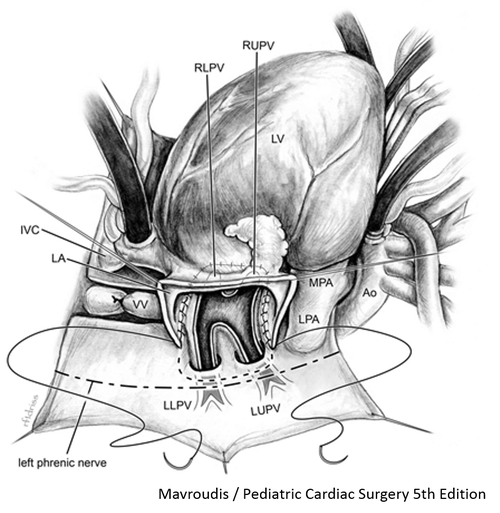Surgery to treat pulmonary vein stenosis
Surgery can be used to treat pulmonary vein stenosis. The surgeon will typically fix the pulmonary veins with a technique called the sutureless repair. The sutureless repair can be called marsupialization as well.
During surgery , the surgeon will cut open the pulmonary veins that are stenotic and relieve the areas that are obstructed. To make the pulmonary veins bigger, the surgeon will sew the atrium to the pericardium around the pulmonary veins to create a new roof over the pulmonary veins and widen the connection to the left atrium. Other approaches us a patch of pericardium ( child's own lining around the heart) or a other materials (Figure 1a and b)
Surgery will require that your child be put to sleep with a general anesthetic and special lines will be placed to monitor their heart and lung function during the operation. Your child will need to be placed on the heart lung machine ( cardiopulmonary bypass) to allow the surgeon to work on the heart.
During surgery , the surgeon will cut open the pulmonary veins that are stenotic and relieve the areas that are obstructed. To make the pulmonary veins bigger, the surgeon will sew the atrium to the pericardium around the pulmonary veins to create a new roof over the pulmonary veins and widen the connection to the left atrium. Other approaches us a patch of pericardium ( child's own lining around the heart) or a other materials (Figure 1a and b)
Surgery will require that your child be put to sleep with a general anesthetic and special lines will be placed to monitor their heart and lung function during the operation. Your child will need to be placed on the heart lung machine ( cardiopulmonary bypass) to allow the surgeon to work on the heart.
Who gets surgery on the pulmonary veins?
Children who have stenosis that is close to the atrium are typically selected for surgery. The surgeon is directly able to fix this area without damaging the lung. A child can have a repair done to one or all the pulmonary veins, depending on the severity and number of veins affected by the disease.
Typically, stenosis in a single pulmonary vein is treated by catheter based interventions or simply observed for progression, unless the child is undergoing cardiac surgery for another reason.
Typically, stenosis in a single pulmonary vein is treated by catheter based interventions or simply observed for progression, unless the child is undergoing cardiac surgery for another reason.
What are the risks associated with surgery?
Surgery is associated with risks because it is an invasive procedure. One of the main risks is bleeding and damage to nearby structures. Talk to your doctor about the risks associated with surgery and what is best for your child.
The sutureless repair was pioneered by Dr. John Coles at the Hospital for Sick Children. This surgery corrects pulmonary vein stenosis by opening up the stenotic area of the pulmonary vein and part of the left atrium. The surgeon then sutures the pericardium to the left atrium over the pulmonary veins to create a new roof that allows blood to flow unobstructed.
